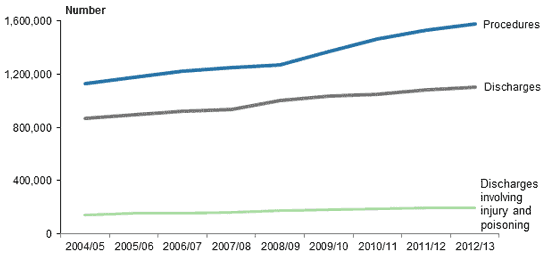Published online:
30 June 2015
Summary
These tables contain national data detailing the numbers of publicly funded patients discharged from, and procedures carried out in both public and private hospitals. An additional spreadsheet containing the same data in machine readable and pivot table formats is also available.
Number of publicly funded discharges and procedures in New Zealand hospitals, 2004/05 to 2012/13

Publicly funded hospital discharges
- There were more than 1.1 million publicly funded discharges from New Zealand hospitals in 2012/13. This equates to 225.4 hospitalisations per 1000 people.
- Each year more females than males are discharged from New Zealand hospitals. For every 100 female hospitalisations there were 80 male hospitalisations in 2012/13.
- Females had higher hospitalisation rates over the child-bearing years, while the hospitalisation rate for males generally increased with age. For both males and females, hospitalisation rates peaked in the 85 years and over age group.
- Nearly a third (31.5%) of hospitalisations in 2012/13 were for people aged 65 and over.
- In 2012/13 Māori accounted for 16 out of every 100 publicly funded hospitalisations.
- Māori had higher hospitalisation rates compared with non-Māori for each year from 2004/05 to 2012/13.
- For both Māori and non-Māori, females had higher hospitalisation rates than males for each year from 2004/05 to 2012/13.
- Compared with 2011/12, there were 2.4 more publicly funded hospitalisations per 1000 people in 2012/13.
- The number of publicly funded hospital discharges increased by 27.0% from 2004/05 to 2012/13 - just over 26,000 more discharges every year.
Publicly funded hospital procedures
- Almost 1.6 million publicly funded procedures were performed in New Zealand hospitals in 2012/13. This equates to 314.2 procedures per 1000 people.
- A third (33.0%) of procedures were performed on people aged 65 and over in 2012/13.
- Each year more procedures are performed on females than males. For every 100 procedures perfomed on females there were 82 performed on males in 2012/13.
- Females aged 15 to 49 had higher procedure rates than males. For all other age groups males had higher procedure rates in 2012/13.
- In 2012/13 Māori accounted for 15 out of every 100 publicly funded procedures.
- Māori had higher hospitalisation rates compared with non-Māori for each year from 2004/05 to 2012/13.
- Compared with 2011/12, there were 4.4 more publicly funded procedures per 1000 people in 2012/13.
- The number of publicly funded hospital procedures increased by 39.6% from 2004/05 to 2012/13 - almost 50,000 more procedures every year.
Publicly funded hospital discharges involving injury and poisoning
- There were almost 200,000 discharges involving injury and poisoning from New Zealand hospitals in 2012/13 - equating to 38.1 hospitalisations per 1000 people.
- Each year more males are hospitalised for reasons involving injury and poisoning compared with females. For every 100 female hospitalisations there were 110 male hospitalisations in 2012/13.
- For each age group, males had higher hospitalisation rates than females in 2012/13. The greatest disparity occurred in the 10–14 and 20–24 age groups, where the male rate was 1.5 times the female rate.
- Māori are more likely to be hospitalised for reasons involving injury and poisoning than non-Māori. For each of the ten years to 2012/13, Māori had higher hospitalisation rates compared with non-Māori.
- The number of hospitalisations involving injury and poisoning increased by 38.7% from 2004/05 to 2012/13 - just over 6000 more discharges every year.
